
Panakkad Syed Mohammedali Shihab Thangal
| Born | 4 May 1936(1936-05-04)
Malappuram, Kerala, India |
|---|
| Died | 1 August 2009(2009-08-01) (aged 73)
Malappuram, Kerala, India |
|---|
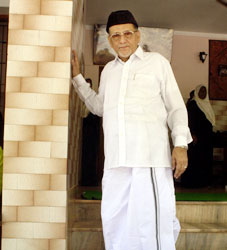
Panakkad Syed Mohammedali Shihab Thangal (Malayalam: പാണക്കാട് മുഹമ്മദലി ശിഹാബ് തങ്ങള്) (May 4, 1936 - August 1, 2009) was a politician, the supreme leader of the E. K. Sunni of Kerala and an Islamic scholar from the Indian state of Kerala. He was the President of the Kerala state committee of the Indian Union Muslim League. Shihab Thangal was a member of the Thangal family who are believed to be descendents of the Prophet Mohammed.



Early life
Shihab Thangal was born as the eldest son of Panakkad Syed Ahmed Pookoya Thangal, who was a renowned Islamic leader of Kerala. He had his primary education at the M.M. High School, Calicut. He continued his religious education at Thalakkadathur and Kananchery Dars under Ponmala Moideen Musliar. In 1958, he left for Egypt for further studies and obtained his master's degree in Arabic literature from Al Azhar University in 1961. He continued his studies in Cairo University and pursued a Doctorate in Arabic Literature in 1966. After spending about eight years in Egypt he returned home in 1966.


In 1967, Thangal married Shareefa Fathima Beevi, daughter of Syed Abdur Rahman Bafaqui Thangal, one of the founder leaders of the Muslim League. After her death in 2006, he married Aysha Beevi. Thangal had two sons: Syed Basheerali Shihab Thangal and Syed Munavarali Shihab Thangal and had four younger brothers: Sayed Umerali Shihab Thangal, Sayed Hyderali Shihab Thangal, Syed Sadiqali Shihab Thangal and Syed Abbasali Shihab Thangal.



Career
Shihab Thangal was appointed as the president of the Kerala state committee of Indian Union Muslim League subsequest to his father's death in 1975. Shihab Thangal remained President until his death in 2009. He was an undisputed leader of the Muslim community in Kerala and was Qazi to hundreds of mahals in Kerala.
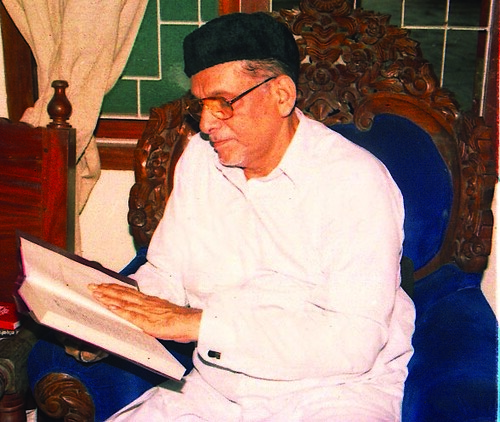


Death
Shihab Thangal died on 1 August 2009 following a cardiac arrest. Thangal was admitted to a private hospital after he slipped and fell down at his home, Panakkad Kodappanakkal. His body was buried at the Panakkad Juma Masjid on 2 August 2009.
Source : Wikipedia

| Born | January 21, 1908(1908-01-21)
Thalayolaparambu, Vaikom |
|---|
| Died | July 5, 1994(1994-07-05) (aged 86
Beypore, Kozhikode |
|---|
| Notable award(s) | Padma Shri, Sahity Akademi Award |
|---|
Vaikom Muhammad Basheer or Vaikkom Muhammad Basheer (born 21 January 1908 ; died 5 July 1994) was a Malayalam fiction writer. He was a humanist, freedom fighter, novelist and short story writer. He is noted for the pathbreaking, disarmingly down-to-earth style of writing that won both literary critics as well as the common man. He is regarded as India's one of the most successful and outstanding writers. Translations of many of his works into other languages has won him worldwide acclaim. His notable works include Baalyakaalasakhi, Shabdangal, Paaththummaayude Aadu, Mathilukal, Ntuppuppaakkoraanaendaarnnu, Anarga Nimisham etc. He was awarded the Padma Sri in 1982. He is fondly remembered as the Beypore Sultan.
Early life
Basheer, born in the village of Thalayolapparampu in northern Travancore, was the eldest child of devout Muslim parents. His father was in the timber business as a contractor, but the business did not do well enough for his large family to live in anything approaching luxury. After beginning his education at the local Malayalam medium school, he was sent to the English medium school in Vaikom, five miles away. While at school he fell under the spell of Mahatma Gandhi. He started wearing Khadar, inspired by the swadesi ideals. When Gandhi came to Vaikom to participate in the Vaikom Satyagraham (1924) Basheer went to see him. He managed to climb on to the car in which Gandhi travelled and touch his hand, a fond memory Basheer later mentioned in many of his writings. He used to visit Gandhi's Satyagraha Ashram at Vaikom daily. He got punished for going late to school due to this.
Freedom struggle involvement before journey
He resolved to join the fight for an Independent India, leaving school to do so while he was in the fifth form. Part of his purpose in joining the Indian National Congress was to help ensure that there was some Muslim representation in the pan-Indian movement.
Since there was no active independence movement in Travancore or Kochi – being princely states – he went to Kozhikode to take part in the Salt Satyagraha in 1930. His group was arrested before they could participate in the satyagraha. At the police station, they were beaten up and later remanded at Kozhikode sub-jail. Basheer was sentenced to three months imprisonment and sent to Kannur prison. He became inspired by stories of heroism by revolutionaries like Bhagat Singh, Sukhdev and Rajguru, who were executed while he was in Kannur jail. He and about 600 political prisoners then at Kannur were released after the Gandhi-Irwin pact of March 1931. Freed from prison, he organised an anti-British movement and edited a revolutionary journal, Ujjivanam ('Uprising'). A warrant was issued for his arrest and he left Kerala.


Journey
After leaving Kerala, he embarked upon a long journey that took him across the length and breadth of India and to many places in Asia and Africa, a journey which spanned seven years, doing whatever work that seemed likely to keep him from starvation. His occupations ranged from that of a loom fitter, fortune teller, cook, newspaper seller, fruit seller, sports goods agent, accountant, watchman, shepherd , hotel manager to living as an ascetic with Hindu saints and Sufi mystics in their hermitages in Himalayas and in the Ganges basin, following their customs and practices, for more than five years. There were times when, with no water to drink, without any food to eat, he came face to face with death.


Imprisonment and after
At Kottayam (1941–42), he was arrested and put in a police station lock-up, and later shifted to another lock up in Kollam Kasba police station. The stories he heard from policemen and prisoners there appeared in later works, and he wrote a few stories while at the lock-up itself. He spent a long time in lockup awaiting trial, and after trial was sentenced to two years and six months imprisonment.

He was sent to Thiruvananthapuram central jail. While at jail, he forbade M. P. Paul from publishing Baalyakaalasakhi. He wrote Premalekhanam (1943) while serving his term and published it on his release. Baalyakaalasakhi was published in 1944 after further revisions, with an introduction by Paul.

He then made a career as a writer, initially publishing the works himself and carrying them to homes in order to sell them. He ran two bookstalls in Ernakulam, Circle Bookhouse and later, Basheer's bookstall.
Once India achieved control of its destiny after obtaining Independence from British rule, he showed no further interest in active politics, though concerns over morality and political integrity are present all over his works.

Well into his forties, he surprised many of his acquaintances by marrying a woman much younger than him (Fabi Basheer) and settling down to a life of quiet domesticity with his wife and two children, Anees and Shahina, in Beypore, on the southern edge of Kozhikode.
During this period he also had to suffer from mental illness and was twice admitted to mental sanatoriums. He wrote one of his most famous works, Paaththummaayude aadu (Pathumma's Goat), while undergoing treatment in a mental hospital in Thrissur. The second spell of paranoia occurred after his marriage when he had settled down at Beypore. He recovered both times, and continued his writings.
He died in Beypore, on 5 July 1994.


Basheer is fondly called as Beypore Sultan (Sultan of Beypore). Though his works have been translated to English and eighteen Indian Languages, the peculiarity of the language he uses makes the translations lose a lot of sheen.
Writing style
Language

Basheer is known for his unconventional style of language. He did not differentiate between literary language and the language spoken by the commons and did not care about the grammatical correctness of his sentences. Initially, even his publishers were unappreciative of the beauty of this language; they edited out or modified conversations. Basheer was outraged to find his original writings transcribed into "standardized" Malayalam, devoid of freshness and natural flow, and he forced them to publish the original one instead of the edited one. Basheer's brother Abdul Khader was a Malayalam teacher. Once while reading one of the stories, he asked Basheer, "where are Aakhyas and aakhyathas (related with Malayalam grammar) in this...?". Basheer shouted at him saying that "I am writing in normal Malayalam, how people speak. and you don't try to find your stupid 'aakhya and aakhyaada' in this"!. This points out to the writing style of Basheer, without taking care of any grammar, but only in his own village language. Though he made funny remarks regarding his lack of knowledge in Malayalam, he had a very thorough knowledge about Malayalam.

Basheer's contempt for grammatical correctness is exemplified by his statement Ninte Lodukkoos Aakhyaadam! ("Your 'silly stupid' grammar!") to his brother, who sermonizes him about the importance of grammar (Paaththummaayude aadu).
Themes
An astute observer of human character, he skillfully combined humour and pathos in his works. Love, hunger and poverty are recurring themes in his works. There is enormous variety in them – of narrative style, of presentation, of philosophical content, of social comment and commitment. His association with India's independence struggle, the experiences during his long travels and the conditions that existed in Kerala, particularly in the neighbourhood of his home and among the Muslim community – all had a major impact on them. Politics and prison,homosexuality, all were grist to his mill. All of Basheer's love stories have found their way into the hearts of readers; perhaps no other writer has had such an influence on the way Malayalis view of love. The major theme of all Basheer stories is love and humanity. In the story "Muchittu Kalikkarente Makal" (The Card Sharp's Daughter), when Sainaba comes out of the water after stealing his bananas, Mandan Muthappa says only one thing: "Sainaba go home and dry your hair else you may fall sick." This fine thread of humanism can be experienced in almost all his stories.

Autobiographical element
One contrast among his works is between those that are primarily autobiographical as far as events and characters are concerned and those that are the product of the author's imagination. This is not to say that a novel or a story will always fall clearly into one category or another; the percentage of factual truth varies considerably. Whatever the case, a book published as fiction is to be read as such, in contrast with one published as 'memoirs'. Works
Almost all of Basheer's writing can be seen as falling under the heading of prose fiction – short stories and novels, though there is also a one-act play and volumes of essays and reminiscences. Basheer's fiction is very varied and full of contrasts. There are poignant situations as well as merrier ones – and commonly both in the same narrative. There are among his output realistic stories and tales of the supernatural. There are purely narrative pieces and others which have the quality of poems in prose. In all, a superficially simple style conceals a great subtlety of expression.

His literary career started off with the novel Premalekhanam, a humorous love story between Keshavan Nair – a young bank employee and an upper caste Hindu (Nair) – and Saramma – an unemployed Christian woman. Hidden underneath the hilarious dialogues we can see a sharp criticism of religious conservatism, dowry and similar conventions existing in society. This was followed by the novel Baalyakaalasakhi – a tragic love story between Majeed and Suhra – which is among the most important novels in Malayalam literature in spite of its relatively small size (75 pages), and is commonly agreed upon as his magnum opus work. In his foreword to Baalyakaalasakhi, Jeevithathil Ninnum Oru Aedu (A Page From Life), M. P. Paul brings out the beauty of this novel, and how it is different from run-of-the-mill love stories.

The autobiographical Janmadinam ("Birthday", 1945) is about a writer struggling to feed himself on his birthday. While many of the stories present situations to which the average reader can easily relate, the darker, seamier side of human existence also finds a major place, as in the novel Shabdangal ("Voices", 1947), which faced heavy criticism for violence and vulgarity.

A scene from the film Mathilukal directed by Adoor Gopalakrishnan based on the novel by Basheer

Mathilukal ("Walls") deals with prison life in the pre-independence days. It is a novel of sad irony set against a turbulent political backdrop. The novelist falls in love with a woman sentenced for life who is separated from him by insurmountable walls. They exchange love-promises standing on two sides of a wall, only to be separated without even being able to say good-bye. Before he "met" Naraayani, the loneliness and freedomlessness of prison life was killing Basheer; but when the orders for his release arrive he loudly protests, "Who needs freedom? Outside is an even bigger jail." The novel was later made into a film (MATHILUKAL, 1989) by Adoor Gopalakrishnan with Mammootty playing Basheer.
Sthalaththe Pradhaana Divyan, Aanavaariyum Ponkurishum, Muccheettukalikkarante makal and Ettukaali Mammoonju featured the life of real life characters in his native village of Thalayolaparambu (regarded as Sthalam in these works).

Awards
- Padma Sri(1982)
- Kendra Sahitya Academy Fellowship
- Kerala Sahitya Academy Fellowship
- Lalithambika Antharjanam Award(1992)
- Muttathu Varkki Award (1993) (Paaththummaayude Aadu)
- Vallathol Award (1993)
Published works
Novels
| # | Name | Translation in English | Year of Publishing |
|---|
| 1 | Premalekhanam | The Love Letter | 1943 |
|---|
| 2 | Baalyakaalasakhi | Childhood Companion | 1944 |
|---|
| 3 | Shabdangal | The Voices | 1947 |
|---|
| 4 | Ntuppuppaakkoraanaendaarnnu | My Grandpa Had an Elephant | 1951 |
|---|
| 5 | Maranaththinte Nizhalil | In the Shadow of Death | 1951 |
|---|
| 6 | Muchcheettukalikkaarante Makal | The Daughter of the Cardshark | 1951 |
|---|
| 7 | Sthalaththe Pradhaana Divyan | The Principal Divine of the Place | 1953 |
|---|
| 8 | Aanavaariyum Ponkurishum | Elephant Scooper and Golden Cross | 1953 |
|---|
| 9 | Jeevithanizhalppaadukal | The Shadows of Life | 1954 |
|---|
| 10 | Paaththummaayude Aadu | Paaththumma's Goat | 1959 |
|---|
| 11 | Mathilukl | Walls (basis of Adoor Gopalakrishnan's 1989 film) | 1965 |
|---|
| 12 | Thaaraa Specials | | 1968 |
|---|
| 13 | Maanthrikapoochcha | The Magic Cat | 1968 |
|---|
| 14 | Prempatta | The Loving Cockroach (Published posthumously) | 2006 |
|---|
Short Stories
| # | Name | Translation in English | Year of Publishing |
|---|
| 1 | Janmadinam | The Birthday | 1945 |
|---|
| 2 | Ormakkurippu | Jottings from Memory | 1946 |
|---|
| 3 | Anargha nimisham | Invaluable Moment (See Anal Haq) | 1946 |
|---|
| 4 | Viddikalude Swargam | Fools' Paradise | 1948 |
|---|
| 5 | Paavappettavarudaey Vaeshya | The Prostitute of the Poor | 1952 |
|---|
| 6 | Vishwavikhkhyaathamaaya Mookku | The World-renowned Nose | 1954 |
|---|
| 7 | Vishappu | The Hunger | 1954 |
|---|
| 8 | Oru Bhagavadgeethayum Kuraey Mulakalum | A Bhagavadgeetha and Some Breasts | 1967 |
|---|
| 9 | Aanappooda | Elephant-hair | 1975 |
|---|
| 10 | Chirikkunna Marappaava | The Laughing Wooden Doll | 1975 |
|---|
| 11 | Bhoomiyudaey Avakaashikal | The Inheritors of the Earth | 1977 |
|---|
| 12 | Shinkidimunkan | The Fools' God Man | 1991 |
|---|
| 13 | Yaa Ilaahi! | Oh God! (published posthumously) | 1997 |
|---|
| 14 | Jeevitham Oru Anugraham | Life is a Gift (published posthumously) | 2000 |
|---|
Others
- Kathaabeejam [Story seed] (Play) (1945).
- Nerum Nunayum [Truth and lie] (Commentary and letters) (1969).
- Ormmayudaey Arakal [The cells of memory] (Commentary and reminiscences) (1973).
- Anuraagaththintaey Dhinangal [The days of desire] (Diary; originally titled Kaamukantaey diary [The diary of the paramour] and changed later on the suggestion of M. T. Vasudevan Nair) (1983).
- Bhargavi Nilayam[Bhaargavi's Mansion] (Screenplay for a film (1964) by A. Vincent which is credited as the first horror cinema in malayalam; adapted from the short story Neelavelichcham [The blue glow]) (1985).
- M. P. Paul (Reminiscences of his friendship with M. P. Paul) (1991).
- Cheviyorkkuka! Anthimakaahalam!! [Hark! The final clarion-call!!] (Speech) (1992).
- Basheerinte Kathukal [Basheer's Letters] (Letters)(Published posthumously) (2008).
Source : Wikipedia
 Padanatha Mohammed Sayeed
Padanatha Mohammed Sayeed
| Born | 10 May 1941(1941-05-10)
Andrott Island, Lakshadweep |
|---|
| Died | 10 December 2005(2005-12-10) (aged 64)
Seoul |
|---|
Padanatha Mohammed Sayeed (May 10, 1941 - December 10, 2005) was a leader of the Indian National Congress party. He was a member of Lok Sabha for eight terms, representing Lakshadweep.
Father's Name Late Shri A.B. Atta Koya Thangal
Date of Birth 10 May 1941
Place of Birth Androth Island (Lakshadweep)
Marital Status Married on 4 January 1967
Spouse's Name Smt. A.B. Rahmath Sayeed
Children One son and seven daughters
Educational Qualifications
B.Com., LL.B.
Educated at Government Arts College, Mangalore (Karnataka)
and Sidhartha College of Law, Bombay (Maharashtra)
Profession
Lawyer, Political and Social Worker
Positions Held
1967 Elected to 4th Lok Sabha
1967-71 Member, Committee on Public Undertakings
1968-69 Member, Joint Committee on Contract Labour
(Regulation and Abolition), Bill, 1967
1969-70 General-Secretary, All India Youth Congress
1971 Re-elected to 5th Lok Sabha (2nd term)
1971-72 Member, Committee on Petitions
1971-74 Member, Joint Committee on Salaries and
Allowances of Members of Parliament
1972-73 Member, Joint Committee on Companies (Amendment)
Bill, 1972
1972-75 and Member, Consultative Committee, Ministry of Communications
1990-91
1973 Member, Joint Committee on Constitution
(Thirty-Second Amendment) Bill, 1973 on Amendment
in Ninth Schedule of the Constitution
1973-74 Treasurer, Parliamentary Forum for Scheduled
Castes and Scheduled Tribes
1974-76 and Member, Committee on Government Assurances
1977-79
1976-77 Member, Consultative Committee constituted under
Tamil Nadu State Legislature (Delegation of Powers)
Act, 1976
1977 Re-elected to 6th Lok Sabha (3rd term)
1979-80 Union Minister of State, Steel, Coal and Mines
1980 Re-elected to 7th Lok Sabha (4th term)
1980 Member, Lakshadweep Territorial Congress Committee
onwards
1984 Re-elected to 8th Lok Sabha (5th term)
1984-86 Member, Joint Committee on Shipping Agents
(Licensing), Bill
1985-86 and Member, Joint Committee on Offices of Profit
1990-91
1984-88 Member, Committee on Estimates
1986 Member, All India Congress Committee (Indira)[A.I.C.C.(I)]
onwards
1989 Re-elected to 9th Lok Sabha (6th term)
1990-96 Member, Rules Committee
1991 Re-elected to 10th Lok Sabha (7th term)
1991-92 Member, General Purposes Committee
1991-92 and Member, Panel of Chairmen
1996-97
1991-93 Member, Joint Committee on the Constitution
(Seventy-Second Amendment) Bill, 1991
Secretary, Congress Parliamentary Party (Indira)[C.P.P.(I)]
1991-95 Member, Committee on Official Language
1992-93 Member, Consultative Committee, Ministry of
Surface Transport
1992-94 Member, Joint Parliamentary Committee to Enquire
into Irregularities in Securities and Banking Transactions
1993-95 Union Minister of State, Home Affairs
1995-96 Union Minister of State, Information and Broadcasting
1996 Re-elected to 11th Lok Sabha (8th term)
1996 Deputy Chief-Whip, Congress Parliamentary Party
onwards
1996-97 Member, Committee on Transport and Tourism
1998 Re-elected to 12th Lok Sabha (9th term)
17 Dec. 1998 Deputy Speaker, Lok Sabha
onwards
Chairman, Committee on Provision of Computers to Members
of Parliament
Chairman, Committee on Private Members' Bills and
Resolutions
Chairman, Committee on Budget of Lok Sabha
Chairman, Library Committee
Member, General Purposes Committee
Member, Business Advisory Committee
Member, Committee on Home Affairs
Member, Committee on Transport and Tourism*
Literary, Artistic and Scientific Accomplishments
Knows seven languages, viz. English, Hindi, Urdu, Malayalam, Kannada,
Tamil and Tulu




Early life
P.M. Sayeed was born in Andrott Island, Lakshadweep. He studied at Government Arts College, Mangalore and at Sidhartha College of Law, Mumbai .

Political career
P.M. Sayeed was first elected to Lok Sabha in 1967 at the age of 26. He served as Union Minister of State, Steel, Coal and Mines in 1979-1980; Union Minister of State, Home Affairs 1993-1995; Union Minister of State, Information and Broadcasting 1995-1996; and Deputy Speaker, Lok Sabha 1998-2004. He was a member of the Congress Working Committee.
He won the Lok Sabha elections in 1967 and continued to win every election till 2004. Then he became a member of the Rajya Sabha representing the National Capital territory of Delhi. He was Union Power Minister when he died in Seoul on 18 December 2005.





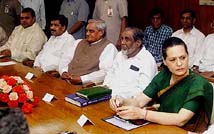
His son Muhammed Hamdulla Sayeed, 26, a Law graduate from Indian Society College in Pune, was elected May 16, 2009 to the Lok Sabha. He defeated Dr P Pookunhikoya of NCP by 2198 votes to become the youngest member of the 15th Lok Sabha.


Source : Wikipedia
Social and Cultural Activities
Associated with various social and cultural activities of
Lakshadweep; instrumental in conducting inter-state cultural
programmes, Lakshadweep festivals in various places and
promoting folk arts Parichakkali, Kolkali and Lava dances, etc.

Special Interests
Social Work, labour welfare, upliftment of the poor, the downtrodden and
the people belonging to minorities
Favourite Pastime and Recreation
Reading, music, public service and computer network
Sports and Clubs
Football, badminton and chess
Countries Visited
Widely travelled (30 countries); Member, Indian Delegation to the
24th Session, UN General Assembly, 1969; and 36th Session, UN General
Assembly, 1982; Leader, Goodwill Delegation to erstwhile G.D.R.,
1970; Member (i) Indian Parliamentary Delegation to 59th I.P.U.
Conference, Paris, 1971; Lome (Togo), 1985; Moscow (former U.S.S.R.),
1988; and to 100th I.P.U. Conference, Moscow, 1998 (ii) International
Solidarity Conference of World Peace Council, Basel, Switzerland, 1979;
(iii) Government of India Haj Delegation, 1988 and its Leader, 1993;
(iv) Indian Delegation to Non-aligned Youth Conference, Algiers; and
represented A.I.C.C. (I) to Baghdad on the occasion of Silver Jubilee
Celebrations of Arab Baath Socialist Party; Indian Delegation to SAARC
Speakers and Parliamentarians Conference, Pakistan and India-China
Friendship Society Delegation to China
Other Information
Chairman, Advisory Board, Non-aligned Congress of Youth;
Member (i) Central Haj Committee, 1968-70; (ii) Central
Haj Advisory Board, 1970-71; (iii) National Welfare of
Seafares Board, 1974-77; (iv) Island Development
Authority, 1984-88; and (v) Court, Jamia Millia Islamia,
since 1990
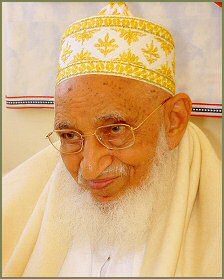
| Born | March 6, 1915 (1915-03-06) (age 95)
Surat, Gujarat, India |
|---|
Doctor Syedna Mohammed Burhanuddin (Urdu: محمد برھان الدین) (born March 6, 1915) is the 52nd Dā‘ī l-Muṭlaq (Dai, or Unrestricted Missionary) of the Dawoodi Bohras. The Dawoodi Bohras are a sub group within the Mustaali, Ismaili Shia branch of Islam.
Biography
Burhanuddin was born in Surat, Gujarat, India. He was appointed to be the future Dā‘ī at the age of 19 by his father, the previous Dā‘ī l-Muṭlaq, Taher Saifuddin. Burhanuddin succeeded his father, upon the latter's death,when he was 53 years of age. He has seven sons and three daughters and all members of his family reside at Saifee Mahal, Mumbai.
Burhanuddin completed recitation of the Quran at the age of six in 1921. At around the age of 13, he escaped an accident when bridge railing collapsed while on travel in Colombo, where his vehicle got hung on one wheel. He got lakab of Burhanuddin at age of 15 on his occasion of misaq. He received the designation of hadiyath (Sheikh) from 51st Dai at the age of 17(1931 A.D.) and later designated as mazoon at the age of 20. He became hafiz at age of 21(1935 A.D.) and married Amatullah Aai two years later.
Much later (1381 AH) he made a trip to Yemen to visit the earlier Dais of Yemen and consequently received the designation of "Mansural-Yaman". At the age of 53(1965 A.D.) he became 52nd Dai on death of his father Taher Saifuddin.
Burhanuddin organised Ashura (Imam Husain's) function at various locations and addressed the gathering of Dawoodi Bohra (invited from all over world):
- Mecca (1969)
- Cairo (1980 and 1981)
- Karachi (1977, 1983, 1987, and 1996),
- Nairobi (1984 and 1998)
- Darussalam (1990)
- Mombasa (2008),
- Mumbai (2005, 2009, 2010 and 2011),
- Houston (2001),
- Colombo (1970, 1991, 1999, 2007, and 2008)
- Dubai (2004),
- Indore (2000).
Education, culture and work for men and women
Burhanuddin supervises the curriculum of the Arabic academy Al Jamea tus Saifiyah and has emphasized education and modernization for both men and women of the community. The quest for knowledge includes religious education as well as secular study in universities throughout the world.It is an Islamic Arabic Academy situated in the heart of Surat city, India which is a leading theological University for Dawoodi Bohras. It was founded in 1814 by the 43rd Dai Syedna Abdeali Saifuddin.
In 1920, Dr Syedna Taher Saifuddin transformed this institution into a university that also promoted education for Bohra girls. With the present Dr Syedna Mohammed Burhanuddin Saheb's vision, the university has seen tremendous expansion and now has state-of-the-art facilities and a competent International Baccalaureate Office (IBO) with acceptance worldwide.
His era has also been marked by a widespread programme of construction of mosques, mausoleums and community buildings in Bohra centres around the world. There is, for example, the Raudat Tahera, the mausoleum of his father Taher Saifuddin in Mumbai, India. The mausoleum has the entire Qur'an engraved on its four walls. This has been done in gold leaf on marble with precious gems encrusted in all the 'Bismillahs' (the opening verses of each individual chapter of the Qur'an). He has also made a contribution to the holy shrine of ‘Alī, the first Shī‘ah Imām and fourth Sunni Caliph.
In 1980, he completed the renovation and restoration of the Mosque of al-Ḥākim in Cairo and since then, several other Fatimid era mosques of Cairo have been restored to their former glory. In the wake of this endeavour, Bohra communities across the world have sought to build their own mosques in their hometowns and Bohra mosques have been constructed as far afield as North America, Europe, Africa and Australia. These community centres and places of worship have fostered both a local and worldwide sense of togetherness and brotherhood which is seen most vividly in the annual gathering to commemorate the martyrdom of Muhammad's grandson, Husayn ibn ‘Alī at Karbala in the seventh century.
Burhanuddin has also contributed towards the re-establishment of the Saifee Hospital in Mumbai in June 2005.
He delivers nine days of sermons every year, the event taking place in a different city each time. Elsewhere, the commemoration also takes place in every Bohra centre across the world, with sermons given by appointed priests to local communities. He also gives scholarships to students in India. He is driving a Trust in Mumbai for this purpose and many Dawoodi Bohra students are assisted by this Trust.
Awards and accomplishments
He holds an Honorary Doctorate from the Aligarh Muslim University in India, Al Azhar University in Cairo, Egypt and University of Karachi Pakistan. Burhanuddin has been awarded the Star of Jordan and the Vishaul Nile.
As per the directions of the then-President of Egypt Gamal Abdel Nasser, Al Azhar University conferred the Degree of Islamic Sciences (Honoris Causa) to Burhanuddin on March 13, 1966..

Masjid Jame-ul-Anwar,Cairo 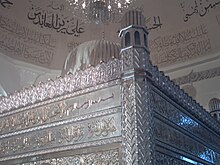
zarih of Raous-us-sohda -e-karbala,Damuscus,Syria 
Zarih maulatena Zainab, Cairo 
Raous-us-Husain,Cairo,Egypt - The Raudat Tahera in Mumbai.
- The repair and renovation of the Mosque Al Jame ul Anwar.
- The repair and renovation of the Mosque Al Aqmar in Egypt.
- The gold plating of Maulana Ali's Zaree in Najaf.
- The gold plating of Maulana Abbas e Alamdaar's Zaree in Karbala.
- The construction of Rasul Husain(Cairo)Zarih in Egypt.
- The Mukalafat-al-Rasool next to Rasul Hussain, where some of the Imams are buried.
- The construction of Maulatena Zainab's Zaree in Egypt.
- The construction/renovation of The Grand Mosque of Kufa.
- The renovation of the maqsurah (musoleam) of Imam Husain (AS)
- The construction of Saifee Hospital in Mumbai (India)
Burhanuddin, who is known as Manṣūrul-Yaman, has turned his particular attention to his followers in Yemen. Under his reign, his followers in Yemen constructed the mausoleum of Hatim Saheb and a mosque in Hutaib Mubarak. He also undertook projects for providing water and electricity to the faiz and town. The roads to ziyarats in Yemen were made more accessible to vehicles by him.
He was elected as the Chancellor of the Muslim University of Aligarh by the Court of the University in its meeting on October 3, 1999. On April 26, 2000 he visited Australia and became the first Da'i al-Mutlaq to have traveled to five continents.
On October 17, 1966, Aligarh Muslim University conferred upon him a Doctorate of Theology at a special convocation.
In June 2004 Mohammed Burhanuddin was conferred a Doctorate of Literature (Honoris Causa) by the Governor of Karachi at a ceremony held at the Karachi University. He has also been honored by the highest civilian ranks of Jordan and Egypt.
The cities of San Jose, Houston, Dallas, Irving and Richmond Hill have accorded him an Honorary Citizenship and Keys to their cities.
In August 2005, he inaugurated a mosque in the United States in Fremont, California. President George W. Bushcongratulated him for this in a letter from the White House. .
Source : Wikipedia





















































